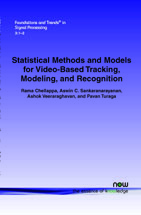Statistical Methods and Models for Video-Based Tracking, Modeling, and Recognition
By Rama Chellappa, Department of Electrical and Computer Engineering, Center for Automation Research, UMIACS, at University of Maryland, rama@cfar.umd.edu | Aswin C. Sankaranarayanan, Department of Electrical and Computer Engineering, Rice University, saswin@rice.edu | Ashok Veeraraghavan, Mistubishi Electric Research Laboratory, veerarag@merl.com | Pavan Turaga, Department of Electrical and Computer Engineering, Center for Automation Research, UMIACS, at University of Maryland, pturaga@cfar.umd.edu
Abstract
Computer vision systems attempt to understand a scene and its components from mostly visual information. The geometry exhibited by the real world, the influence of material properties on scattering of incident light, and the process of imaging introduce constraints and properties that are key to interpreting scenes and recognizing objects, their structure and kinematics. In the presence of noisy observations and other uncertainties, computer vision algorithms make use of statistical methods for robust inference. In this monograph, we highlight the role of geometric constraints in statistical estimation methods, and how the interplay between geometry and statistics leads to the choice and design of algorithms for video-based tracking, modeling and recognition of objects. In particular, we illustrate the role of imaging, illumination, and motion constraints in classical vision problems such as tracking, structure from motion, metrology, activity analysis and recognition, and present appropriate statistical methods used in each of these problems.
Statistical Methods and Models for Video-based Tracking, Modeling, and Recognition
Computer vision systems attempt to understand a scene and its components from mostly visual information. The geometry exhibited by the real world, the influence of material properties on scattering of incident light, and the process of imaging introduce constraints and properties that are key to solving some of these tasks. In the presence of noisy observations and other uncertainties, the algorithms make use of statistical methods for robust inference. Statistical Methods and Models for Video-based Tracking, Modeling, and Recognition highlights the role of geometric constraints in statistical estimation methods, and how the interplay of geometry and statistics leads to the choice and design of algorithms. In particular, it illustrates the role of imaging, illumination, and motion constraints in classical vision problems such as tracking, structure from motion, metrology, activity analysis and recognition, and appropriate statistical methods used in each of these problems
